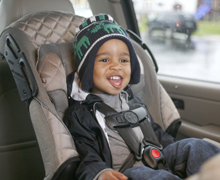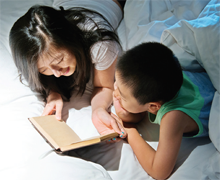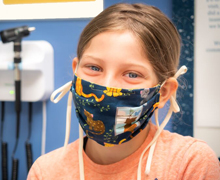Winter 2021
Grieving Life Before COVID-19
 Life during the coronavirus pandemic is often described as ‘the new normal.’ But it’s not! There’s nothing normal about constant uncertainty, fear, disruption and disappointment. As the pandemic wears on, people of all ages are experiencing grief. We’re grieving the loss of everyday life before COVID-19.
Life during the coronavirus pandemic is often described as ‘the new normal.’ But it’s not! There’s nothing normal about constant uncertainty, fear, disruption and disappointment. As the pandemic wears on, people of all ages are experiencing grief. We’re grieving the loss of everyday life before COVID-19.
Our kids are missing important activities like seeing their classmates at school, having a group of friends over, playing on a sports team, going to sleepovers, and enjoying the latest superhero movie in a big theater. They’re mourning the loss of special plans and family traditions that were stolen by the pandemic: their own birthday party, a graduation ceremony, a trip to Disneyland, visiting grandparents, big holiday gatherings… It’s a very long list! And of course, many kids have lost a stable and familiar way of life due to their parents’ lost wages and job uncertainty.
In addition to grieving the loss of normal life, many children have also lost a loved one during the pandemic – someone they likely couldn’t visit before death. On top of that, these children haven’t had the benefit of rituals like funerals and memorial services that offer comfort and closure.
Grief can come and go, and we all experience it in a variety of ways. Some amount of anxiety, sadness, denial and anger is normal – and so are minor changes in sleep and appetite. It’s important that we talk with our kids about their feelings and help them express all their emotions. And of course, it’s crucial that we model healthy coping behaviors. This link has more on grief and loss, and how families can work through it all in a positive way.
Speaking of positive, many families are finding creative new ways to do things in the midst of a pandemic, like virtual gatherings and drive-by celebrations. Families are also forming ‘make-good’ plans for the post-pandemic future. It’s fun to dream up these plans, such as having two Thanksgiving dinners in a single year, taking a family vacation at a favorite destination, tightly embracing everyone on your missed-hugs list, hosting a mask-burning party, or gathering with family and friends to re-celebrate all the missed birthdays – complete with a dozen different cakes and a dozen flavors of ice cream.
Here’s to the end of the pandemic, and to a new appreciation of how amazing ‘normal’ can be!
Visit Supporting Mental Wellness and Family Life During COVID-19 to learn more.
What Are Antibodies?
 We’re hearing a lot about antibody testing for COVID-19. But what are antibodies? Simply put, whenever our immune system meets a new germ, it makes new antibodies that ‘remember’ it so that the next time that germ shows up, those antibodies alert our body and help it fight off the threat before it can make us sick.
We’re hearing a lot about antibody testing for COVID-19. But what are antibodies? Simply put, whenever our immune system meets a new germ, it makes new antibodies that ‘remember’ it so that the next time that germ shows up, those antibodies alert our body and help it fight off the threat before it can make us sick.
One way to gain these essential antibodies is getting sick with a disease. But the best and safest way is through a vaccine – which allows you to skip the sickness and go straight to being protected. Today, through the rigorous trial process, U.S. scientists are developing a vaccine (and likely more than one) that will safely give us effective antibodies to coronavirus.
Visit the CDC for the latest on COVID-19 vaccines.
Cold-Weather Car Seat Safety
 Bundling up your child in cold weather can create an extra challenge when it comes to ensuring they are safely buckled into their car seat. When kids are wearing bulky clothes or are wrapped in a blanket, it causes the car seat harness to fit improperly. In a crash, the fluffy padding or fill material immediately flattens from the force, creating extra space under the harness. A child can then slip through the straps and be thrown from the seat.
Bundling up your child in cold weather can create an extra challenge when it comes to ensuring they are safely buckled into their car seat. When kids are wearing bulky clothes or are wrapped in a blanket, it causes the car seat harness to fit improperly. In a crash, the fluffy padding or fill material immediately flattens from the force, creating extra space under the harness. A child can then slip through the straps and be thrown from the seat.
Bulky or puffy clothing, including winter coats and snowsuits, should not be worn underneath the harness. Instead, dress your child in thin layers (like cozy fleece and leggings), then add a hat, gloves, socks and footwear for warmth. After ensuring the harness fits snugly, place a coat or blanket over the straps. One easy trick – after buckling up – is to have your child extend their arms straight forward, then slide the coat sleeves up their arms, so they’re wearing it backwards.
Also, remember to keep an emergency bag in the car with extra blankets, water, snacks and a first-aid kit.
Reducing Sugar in Your Child’s Diet
 Most kids consume too much sugar, and it’s putting their health at risk. A diet that’s too high in sugar can lead to serious problems including obesity, heart disease and diabetes.
Most kids consume too much sugar, and it’s putting their health at risk. A diet that’s too high in sugar can lead to serious problems including obesity, heart disease and diabetes.
The American Heart Association says children should have no more than 3 to 4 teaspoons (12 to 16 grams) of sugar per day. But limiting sugar can be tricky. Many foods and drinks contain extra sugar that goes in during processing, known as ‘added sugar.’ While most food labels now list added sugar separately, it’s still important to check labels for the many different names used for sugar, including corn sweetener, high-fructose corn syrup, dextrose, fructose and glucose. And keep in mind that ‘healthy’ foods like yogurt, bread, cereal, tomato sauce and soup can contain a surprising amount of added sugar.
It’s best to eat mostly whole, unprocessed food – including lots of fresh or frozen fruits and vegetables. When it comes to beverages, make water your go-to drink. Milk is also a good option; while it does contain natural sugar (lactose) it provides calcium, protein, vitamin D and other nutrients. Fresh fruit is a better option than fruit juice. The American Academy of Pediatrics recommends no more than 4 ounces of 100% fruit juice per day for children ages 1 to 3. For kids ages 4 to 6, no more than 4 to 6 ounces, and for ages 7 to 14 no more than 8 ounces. Infants under 1 year old should never have fruit juice. And say no to soda: a 12-ounce can has a whopping 10 teaspoons (40 grams) of added sugar – that’s roughly triple the daily maximum recommended amount!
Visit our Nutrition team’s handout to learn more about where sugar is found.
Triple-Safe Storage for Firearms
 When it comes to storing firearms safely, it’s important to keep in mind that ‘hidden’ is not the same as safe. Kids are naturally curious explorers, and are very likely to find any hidden firearm. And when they do – even when they’ve been warned to never touch a gun – the temptation to play with it can be too much to resist.
When it comes to storing firearms safely, it’s important to keep in mind that ‘hidden’ is not the same as safe. Kids are naturally curious explorers, and are very likely to find any hidden firearm. And when they do – even when they’ve been warned to never touch a gun – the temptation to play with it can be too much to resist.
If there is a firearm in your home, locking it up is the only sure way to prevent a tragedy. Always practice triple-safe storage: store guns unloaded and locked up, then lock away ammunition separately, in a different location. Ask family and friends to use these safe-storage steps.
When firearms and ammunition are securely stored, suicide by firearm is reduced by 78% and accidental shootings are reduced by 85%.
Healthy Sleep Habits
 Do you count down the minutes to your child’s bedtime so you can get some chores done, or have some quiet time for yourself? You’re not alone! Ensuring your child gets a restful sleep requires good ‘sleep hygiene’ – which refers to helpful routines and habits.
Do you count down the minutes to your child’s bedtime so you can get some chores done, or have some quiet time for yourself? You’re not alone! Ensuring your child gets a restful sleep requires good ‘sleep hygiene’ – which refers to helpful routines and habits.
Consistency is key: stick to regular bedtimes and wake times. Create calming before-bed rituals like bathing, brushing teeth and story time. In the hour or so before bedtime, avoid high-stimulation activities, including exercise and screen time. Make sure their bedroom is cool and quiet, and that their bed and PJs are clean and comfortable. Ideally, their bed should be a place just for sleeping – not for remote learning and other daytime activities.
Catch Up on Checkups
 The year 2020 was full of special challenges, many of which we’ll continue to face in 2021. As complicated and hectic as family life has been since the pandemic began, if you’ve put well-child visits and dental cleanings on the back burner, it’s important to get them scheduled now.
The year 2020 was full of special challenges, many of which we’ll continue to face in 2021. As complicated and hectic as family life has been since the pandemic began, if you’ve put well-child visits and dental cleanings on the back burner, it’s important to get them scheduled now.
Regular medical checkups are a chance to track growth and development, catch up on missed vaccines and screen for mental wellness. These visits are also a time to touch base on whatever you have questions about, including your child’s sleep, safety, nutrition and exercise. And remember that dental health is a key part of your child’s overall health; being faithful with regular checkups helps prevent future problems.
Check out the American Academy of Pediatrics Schedule of Well-Child Care Visits.
Quick Tip
Have you heard the saying, “There’s no bad weather, only bad clothing?” Bundle up and get your child or teen moving their body outside every day.


